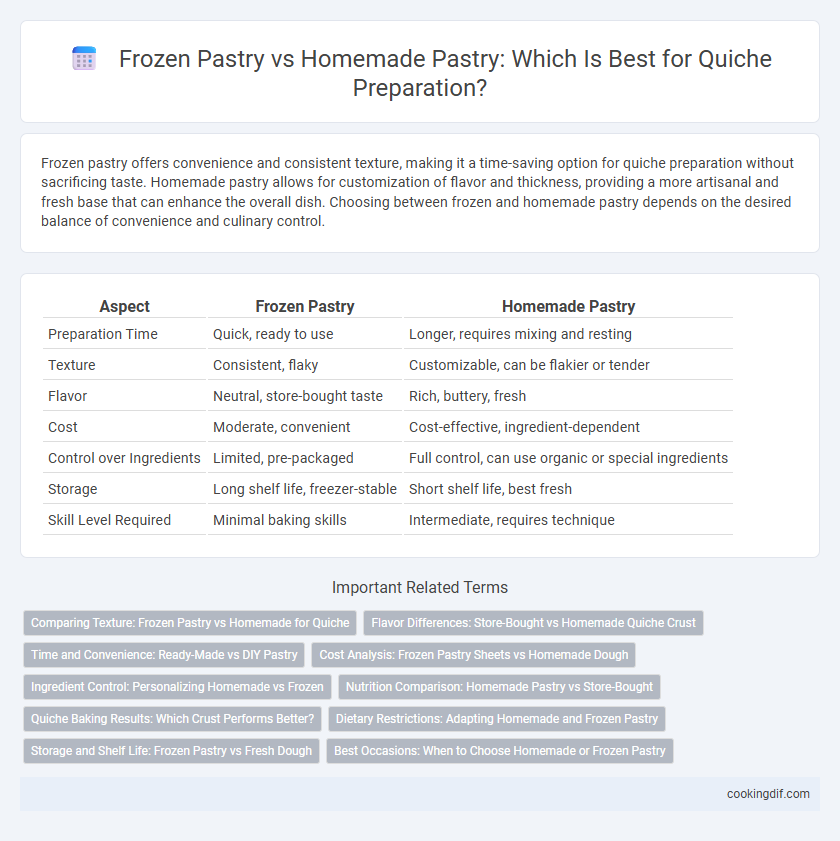Frozen pastry offers convenience and consistent texture, making it a time-saving option for quiche preparation without sacrificing taste. Homemade pastry allows for customization of flavor and thickness, providing a more artisanal and fresh base that can enhance the overall dish. Choosing between frozen and homemade pastry depends on the desired balance of convenience and culinary control.
Table of Comparison
| Aspect | Frozen Pastry | Homemade Pastry |
|---|---|---|
| Preparation Time | Quick, ready to use | Longer, requires mixing and resting |
| Texture | Consistent, flaky | Customizable, can be flakier or tender |
| Flavor | Neutral, store-bought taste | Rich, buttery, fresh |
| Cost | Moderate, convenient | Cost-effective, ingredient-dependent |
| Control over Ingredients | Limited, pre-packaged | Full control, can use organic or special ingredients |
| Storage | Long shelf life, freezer-stable | Short shelf life, best fresh |
| Skill Level Required | Minimal baking skills | Intermediate, requires technique |
Comparing Texture: Frozen Pastry vs Homemade for Quiche
Frozen pastry for quiche offers a consistently flaky texture due to its industrial lamination process, while homemade pastry provides a more tender and buttery crumb, allowing for greater control over thickness and ingredient quality. The rigidity of frozen pastry can sometimes result in a firmer crust that contrasts with the softer filling, whereas homemade pastry often yields a delicate balance between crispness and softness, enhancing the overall mouthfeel. Temperature control during baking significantly affects both types: frozen pastry benefits from a properly preheated oven to maintain its layers, while homemade dough requires careful handling to avoid toughness.
Flavor Differences: Store-Bought vs Homemade Quiche Crust
Frozen pastry often lacks the rich, buttery flavor and flaky texture that defines a high-quality quiche crust due to preservatives and shorter refrigeration times. Homemade pastry allows control over ingredient quality, resulting in a fresher taste and more tender, crisp layers that enhance the overall flavor profile of the quiche. The flavor complexity of a homemade crust greatly complements the filling, making the quiche more satisfying compared to store-bought alternatives.
Time and Convenience: Ready-Made vs DIY Pastry
Frozen pastry offers significant time savings and convenience for quiche preparation, eliminating the need for dough kneading and chilling. Homemade pastry requires more preparation time but allows precise control over ingredients and texture, enhancing flavor and quality. For quick meals, ready-made pastry is ideal, while homemade options suit those prioritizing culinary customization.
Cost Analysis: Frozen Pastry Sheets vs Homemade Dough
Frozen pastry sheets offer a cost-effective option for quiche preparation due to lower upfront ingredient costs and reduced preparation time, making them ideal for budget-conscious cooks. Homemade dough can increase expenses slightly through ingredient use like butter and flour, but it provides greater control over quality and flavor, potentially justifying higher costs for gourmet results. Comparing overall cost, frozen sheets save labor time and reduce waste, while homemade dough may involve more resource investment but can yield a superior, customizable quiche crust.
Ingredient Control: Personalizing Homemade vs Frozen
Homemade pastry for quiche allows precise control over ingredient quality and quantity, enabling customization of flour types, fats, and seasonings to suit dietary preferences and ensure freshness. Frozen pastry, while convenient and consistent, often contains preservatives and stabilizers that limit ingredient transparency and personalization. Choosing homemade crust enhances the ability to tailor flavors and textures, aligning with specific nutritional goals and taste profiles.
Nutrition Comparison: Homemade Pastry vs Store-Bought
Homemade quiche pastry often contains fresher ingredients and allows for control over fats, resulting in lower trans fats and sodium levels compared to store-bought frozen pastry, which may include preservatives and hydrogenated oils. Nutritionally, homemade pastry typically offers higher protein and fiber content when using whole grain flours, enhancing overall nutrient density. Store-bought frozen pastries provide convenience but often have increased calories and unhealthy fats that can impact heart health negatively.
Quiche Baking Results: Which Crust Performs Better?
Frozen pastry often provides a consistently flaky and buttery crust due to its controlled fat content and uniform thickness, ideal for quiche baking. Homemade pastry allows customization of ingredients and texture, delivering a personalized flavor but may risk uneven baking or sogginess if not prepared correctly. Overall, frozen pastry frequently outperforms homemade crusts in reliability and texture during quiche preparation.
Dietary Restrictions: Adapting Homemade and Frozen Pastry
Frozen pastry offers convenience and consistent texture but may contain preservatives, gluten, or dairy, posing challenges for those with dietary restrictions. Homemade pastry allows precise control over ingredients, making it easier to adapt recipes for gluten-free, vegan, or low-fat diets by substituting flours or fats. Choosing between frozen and homemade pastry depends on the need for dietary customization and ingredient transparency in quiche preparation.
Storage and Shelf Life: Frozen Pastry vs Fresh Dough
Frozen pastry offers extended shelf life, typically lasting up to 6 months when stored properly at -18degC (0degF), maintaining its freshness and preventing spoilage. In contrast, homemade fresh dough has a much shorter storage period, usually best used within 2-3 days when refrigerated at 4degC (39degF) to avoid souring or drying out. Proper storage techniques for frozen pastry, such as airtight packaging, ensure optimal texture and flavor retention for quiche preparation.
Best Occasions: When to Choose Homemade or Frozen Pastry
Homemade pastry is ideal for special occasions or when a flaky, buttery texture is desired, allowing for customization of thickness and flavor. Frozen pastry is convenient for quick meals or casual gatherings, saving time while still delivering a reliable crust that holds up well under various fillings. Choosing between homemade and frozen pastry depends on the balance of preparation time, desired taste, and the level of formality for the event.
Frozen pastry vs homemade pastry for quiche preparation Infographic

 cookingdif.com
cookingdif.com